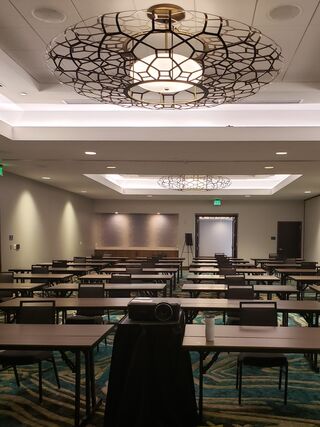Education
What's It Like Teaching in a College Classroom During COVID?
With decorative masks and sanitized hands, the learning continues.
Posted September 4, 2020

Like most educators, I was apprehensive about going back to the classroom this fall. But, so far, it's been surprisingly smooth and almost feels normal.
I teach writing at the University of Colorado Boulder, which is offering a mixture of in-person, hybrid, and remote classes this fall in an effort to accommodate as many students, near and far, as possible. My three classes are all in-person and held in venues large enough for dozens of students and, in one case, a ballroom in a new hotel in downtown Boulder with a capacity of 161 people for just me and my 11 students. Students have plenty of space for themselves in each venue. There are card-secured entries for all buildings, reminders everywhere to wear masks at all times, alcohol wipes in every classroom, daily health questionnaires, and tents set up all over campus for regular COVID-19 screenings.
Not the same campus we all left in mid-March, dazed and confused about what would come next, yet it's surprisingly calm and comfortable. There is a sense that the powers that be spent a lot of time, energy, and mental effort this past summer to anticipate needs and ensure the health and safety of all on-campus and off. The campus is quieter, with some students opting for fully remote classes, big chunks of time between classes, stairways designated up only or down only, and building entrances designated as entrance only or exit only to ensure efficient crowd flow and ease of movement. It never feels crowded or too busy on campus now, actually.
Some challenges have included trying to hear the soft-spoken students who sit toward the back of the larger venues and speak from behind their cloth masks as I strain to hear them over the fan from the projector. My students might suspect I'm losing my hearing (not yet!) when I ask them to speak up, but it's good for freshmen to find their voice anyway. For peer review sessions, I used to have students swap laptops, but in light of COVID-19, we’re instead using google docs exclusively, where students do edits and make comments right on their peer’s document, and then give a minute or two of verbal feedback from a safe distance of six feet.
All in all, I've been impressed with my students (who are all freshmen—what a way to start college...!) who have shown resilience, flexibility, and a positive attitude, despite the obvious challenges and stressors. So far, they seem willing to go with new routines, so long as it means they get to be in college, on their own, moving on with the new stage in life they worked so hard to get to.
I look forward to teaching without a mask, to sitting next to my students again, brainstorming the perfect sentence with them, and just the feeling of relief we'll all have when things are "back to normal"—but for now, it's as close as we're going to get. Because CU Boulder offered lots of options for different methods of learning and we—myself and my students—all opted for in-person learning, there’s a real sense of “we’re in this together.” We’re doing it safely and respectfully and, it seems, excited to be able to do this successfully during a global pandemic. So far, so good.


